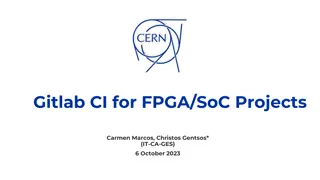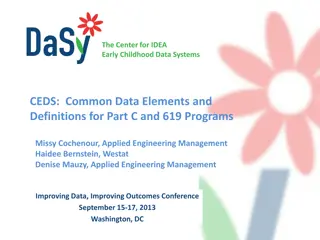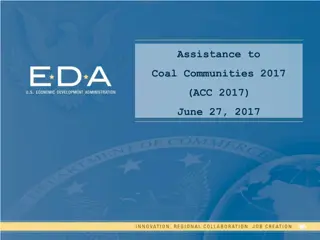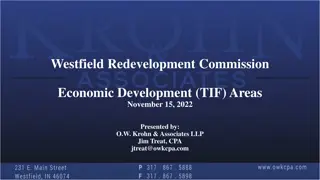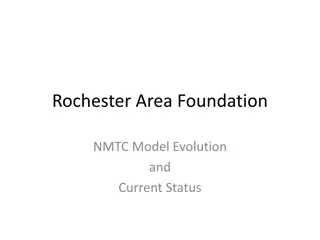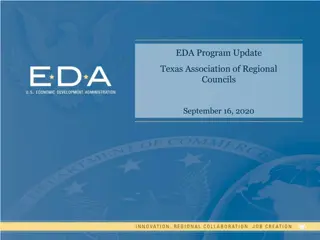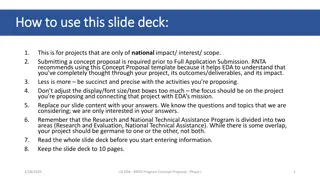
Comprehensive Economic Development Strategies
A Comprehensive Economic Development Strategy (CEDS) is a locally-driven planning process that plays a crucial role in economic development. It engages community leaders, leverages private sector involvement, and establishes a strategic blueprint for regional collaboration. The process involves assessing the region's current status, setting future goals, evaluating progress, and mapping out the steps to achieve regional prosperity. The evolution from old CEDS requirements to new content guidelines focuses on crafting impactful documents and providing structure for creating effective plans.
Download Presentation

Please find below an Image/Link to download the presentation.
The content on the website is provided AS IS for your information and personal use only. It may not be sold, licensed, or shared on other websites without obtaining consent from the author. If you encounter any issues during the download, it is possible that the publisher has removed the file from their server.
You are allowed to download the files provided on this website for personal or commercial use, subject to the condition that they are used lawfully. All files are the property of their respective owners.
The content on the website is provided AS IS for your information and personal use only. It may not be sold, licensed, or shared on other websites without obtaining consent from the author.
E N D
Presentation Transcript
CEDS OMB Community Solutions Webinar November 15, 2016
What is a Comprehensive Economic Development Strategy (CEDS)? Locally based, regionally-drive economic development planning process Economic development planning, as implemented through the CEDS, is not only a cornerstone of EDA s programs, but successfully serves as a means to engage community leaders, leverage the involvement of the private sector, and establish a strategic blueprint for regional collaboration Provides the capacity building foundation by which the public sector, working in conjunction with other economic actors (individuals, firms, industries), creates the environment for regional prosperity. 2
The CEDS Process Where are we as a Region? Where do we want to go as a Region? How are we doing as a Region in getting there? How do we get there as a Region? 3
EDAs old CEDS Requirements Previously, EDA s regulations included a list of specific technical requirements for the CEDS Checking the boxes approach to the CEDS document The Project List Suggested vs. vital projects Required the projected number of jobs to be created and sources of funding for each project 4
EDAs new CEDS Content Guidelines Are intended to help regional planning organizations craft more impactful CEDS. Focuses almost exclusively on content (versus process). Offers suggestions on what should be included in each of the required sections (per the regulations), and recommends tools, resources and examples to help in the development of the CEDS document ( Recommended Resource ). 5
How are the CEDS Content Guidelines structured? 1. Overview 2. Content Summary Background SWOT Analysis Strategic Direction/Action Plan Evaluation Framework Economic Resilience 3. Format 4. Preparation 5. Equivalent/Alternative Plans 6
Recommended Resources Example CEDS Links to the documents posted online 7
What are the formatting recommendations? 1. Keep your audience in mind Target page length Executive summary Use appendices 2. Communicate creatively Appealing look-and-feel Alternate formats 3. Think beyond the document Consider stakeholder engagement 8
What are the content recommendations? 1. Linking the sections to improve CEDS focus and measurable impact 2. Including key elements such as workforce, broadband, energy, etc. 3. Emphasizing measurable goals/strategies rather than a stand-alone list of projects 4. Integrating/leveraging other planning efforts and resources 5. Infusing economic resilience into the CEDS 9
Economic Resiliency Economic resiliency = An area s ability to withstand, prevent, or quickly recover from major disruptions (i.e., shocks ) to its underlying economic base. CEDS serves as a critical mechanism to help regions identify vulnerabilities and withstand or recover from disruptions. Steady-state initiatives: longer-term efforts that seek to bolster a community s ability to withstand or prevent a shock Responsive initiatives: establishing capabilities that allow an organization/region to be responsive to region s recovery needs following an incident 10
Equivalent/Alternative Plans EDA may accept as a CEDS any locally, state, or regionally prepared plan, or a plan prepared under any Federally supported program if: plan is current plan preparation and contents address EDA s regulations plan is consistent with the Guidelines Nesting -- Previously approved CEDS should be folded into the new plan by leveraging the existing action/implementation plans and evaluation frameworks to effectively inform the newer plan. When developing a regional plan that can also serve as a CEDS alternative document start by engaging the appropriate EDA regional office who can help guide the process and ensure the new plans meet the basic requirements noted above. 11
U.S. Economic Development Administration U.S. Department of Commerce www.eda.gov Michelle Velazquez, AICP Economic Development Specialist Tel: (312) 789-9766 Email: mvelazquez@eda.gov Jeannette P. Tamayo, Regional Director Tel: (312) 789-9760 Email: jtamayo@eda.gov Gregory A. Becker, Management Analyst Tel: (312) 789-9765 Email: gbecker@eda.gov 12



